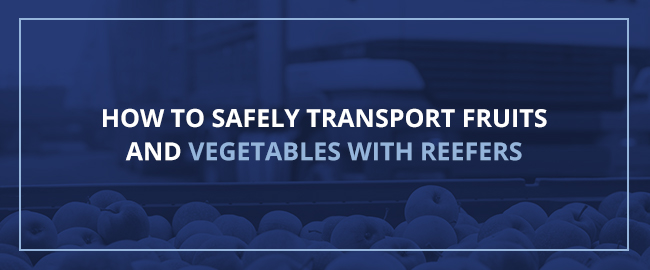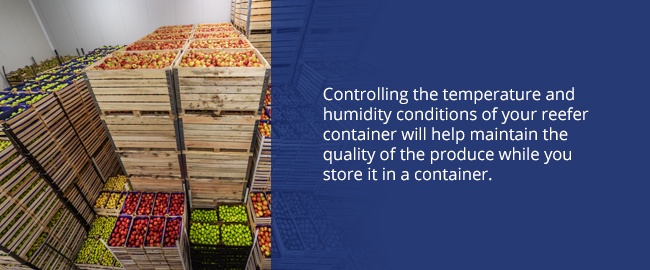
Industries all around the world transport fresh produce every day. The process of shipping fruits and vegetables includes plenty of planning and coordination to make sure produce arrives at its destination still fresh and ready for consumption. There is a strict time frame for transporting fruits and vegetables because of the ripening process most produce experiences. After people harvest the fruits and vegetables, they are still fresh and alive and must be transported properly to stay edible.
Using the right shipping containers for transporting fresh produce can help improve the quality and condition of the fruits and vegetables upon arrival. Units like reefer containers can be a great solution for how to transport vegetables and fruits. Learn more about the ins and outs of fruit and vegetable transportation below.
Table of Contents
- What Is a Reefer Container?
- Why Are Reefers Great for Transporting Produce?
- What Is the Ideal Reefer Temperature for Fruits and Vegetables?
- Conditions for Vegetables
- Conditions for Fruits
- Transporting Fruits and Vegetables With Reefers
- Contact Klinge Corporation for Reefer Containers
What Is a Reefer Container?
“Reefer” is a term that refers to a refrigerated storage container. Reefer containers have a system that maintains certain temperatures and controls humidity levels while allowing acceptable airflow. Refrigerated containers are useful for transporting products including food, pharmaceuticals, chemicals and more. Companies depend on climate control to keep certain materials in prime condition, and reefer containers are perfect for shipping and storing these goods.
Why Are Reefers Great for Transporting Produce?
Companies that work with fresh produce want to ensure their transportation is as safe and efficient as possible. These items are delicate freight because of their limited shelf life and continuous ripening post-harvest.
It’s beneficial to organize a solid plan of operations when transporting produce items. Using reefer containers can help promote a successful shipping process. The refrigeration system in reefer containers circulates fresh air and removes carbon dioxide or other gas. These gases can possibly lead to premature spoilage of the fruits and vegetables you are shipping. These refrigeration systems play a vital role in conserving the condition of produce items.
Reefer containers are able to control temperatures because of several internal components. These components make reefer containers a smart choice for your fruit and vegetable transportation needs:
- Control unit: Adjust the internal temperature, humidity levels and ventilation of the reefer storage container.
- Interior fans: The fans help with air circulation inside the reefer container.
- Fresh air vent: Fruit-ripening gases can escape through the air vent, and fresh air can flow inside the container.
- Unit evaporator: The unit evaporator maintains moisture and humidity levels inside the container. Excess moisture can spoil food products, so the evaporator is an important component.
- Condenser: The condenser takes air from the container and circulates it using an air condenser coil and fan.
These components allow the reefer container to function properly and transport your sensitive materials like vegetables and fruit.

What Is the Ideal Reefer Temperature for Fruits and Vegetables?
The reefer temperature for produce is one of the most important factors that affect the condition of produce items. Both fruits and vegetables require specific shipping conditions to successfully arrive at their destination. You don’t want to run into a situation where shipping and handling errors result in product damage. Around 10% to 40% of produce and crops are lost because of improper storage and shipping conditions.
Controlling the temperature and humidity conditions of your reefer container will help maintain the quality of the produce while you store it in a container. To set the temperature on a reefer container, you can use the control unit on the outside of the container. Before setting the temperature, you want to make sure the container is getting power from a genset or a power cord.
Also, it’s important to understand that the reefer container is meant to maintain the temperature of products, not change them. You should make sure products are already at the correct temperature before loading them into the reefer container.
Conditions for Vegetables
The reefer container temperature for vegetables should range between -1 to 13 degrees Celsius (30-55 degrees Fahrenheit), depending on the type of vegetable. Each vegetable varies in storage life expectancies, humidity levels and freezing points.
Here are a few examples of vegetables and their proper storage conditions:
- Broccoli: 0 C (32 F)
- Brussels sprouts: 0 C (32 F)
- Carrots: 0 C (32 F)
- Green beans: 4 to 7 C (40-45 F)
- Cucumbers: 10 to 13 C (50-55 F)
- Garlic: 0 C (32 F)
- Eggplant: 8 to 12 C (46-54 F)
- Onion: 0 C (32 F)
- Spinach: 0 C (32 F)
Conditions for Fruits
How is fruit transported around the world? Fruit can travel great distances when you understand the correct temperatures you need to store all pieces of fruit. Fruits should stay in a storage container that maintains temperatures ranging from -1 to 4 degrees Celsius (30-40 degrees Fahrenheit).
Safely transport fruits at their proper storage temperature conditions:
- Apples: -1 to 4 C (30-40 F)
- Blackberries: -0.5 to 0 C (31-32 F)
- Raspberries: -0.5 to 0 C (31-32 F)
- Strawberries: 0 C (32 F)
- Cherries: -1 to -0.5 C (30-31 F)
- Grapes: -0.5 to 0 C (31-32 F)
- Peaches: -0.5 to 0 C (31-32 F)
- Pears: -1.7 to -0.5 C (29-31 F)
The reefer container temperature for fruits should remain accurate to provide high-quality produce for markets and stores.
Transporting Fruits and Vegetables With Reefers
Transporting produce is a crucial part of the process of delivering fruits and vegetables from the grower to the consumer. When you store produce correctly in a reefer container, you know your materials will be secure all the way to their delivery destination.
It’s important to know how to pack a reefer storage container to allow for optimal function. If you pack a container and block certain components of the refrigeration system, the temperature and airflow might not work properly and food can spoil. Follow these tips for packing your reefer container:
- Choose a loading pattern that suits your type of cargo.
- Don’t cool the reefer container before you open it.
- Make sure your cargo of fruits and vegetables is at the correct temperature before you load it in the container.
- Don’t load your cargo over the max load line.
- Avoid packing too tightly against the container walls as this could prevent proper air circulation.

Contact Klinge Corporation for Reefer Containers
Transporting vegetables and fruits is a significant step in successfully selling these products. Choosing a reefer container to ship your produce items will be beneficial for your company by helping to deliver food in quality condition. Use high-quality shipping containers for your transportation needs. If you’re looking for new reefer storage containers, contact Klinge Corporation.
As a leader in the industry, many companies utilize our refrigerated storage containers to transport various products like food, medicine, flowers and chemicals. Talk to a specialist on our team to discuss adding a reefer container to your shipping operations, or give us a call at 717-840-4500 to learn more about our products today.
